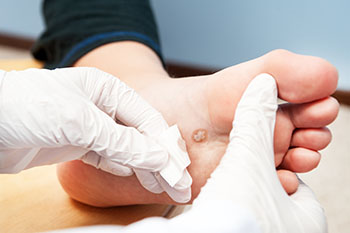Connect With Us
Plantar Warts

Plantar Warts occur when a virus enters the body through cuts or breaks in the skin and causes non-cancerous growths to build up on the soles of the feet. Plantar warts are not dangerous, but they can be painful and resistant to treatment.
Plantar warts are caused by contact with the human papillomavirus (HPV), which is usually found in warm, moist areas like showers or swimming pools. Many people acquire the virus by walking barefoot in public places. The wart is a buildup of skin that forms as the body’s immune system tries to fight the virus.
A plantar wart looks like a small, grainy bump on the sole of the foot, much like a callus. The bump may have small, black pinpoints inside it, which are clotted blood vessels. The wart may also cause pain in the foot when walking.
Some warts will disappear on their own. Other treatment options include use of a wart medication such as salicylic acid, or freezing the wart with liquid nitrogen. Warts that are particularly resistant to treatment may require minor surgery or use of an electrified needle.
